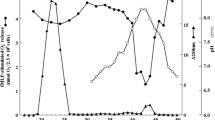Abstract
The inhibitory effects of gold compounds on the NADPH oxidase system of human polymorphonuclear leukocytes (PMNs) has been investigated. Auranofin (0.5-4.0 μg An/ml) suppressed the rate of Superoxide anion generation as well as the total yield in cells stimulated with phorbol myristate acetate and f-Met-Leu-Phe. This implies that drug action may be occurring at the level of protein kinase C or steps subsequent to this in the signal transduction sequence. Sodium aurothiomalate (1–100 μg Au/ml) lacked such activity. Neither gold compound altered the ability of the granule-rich fraction of PMNs to produce oxy radicals whether this fraction was obtained from drug-treated cells or was treated after its isolation. Therefore, in order for auranofin to exhibit its inhibitory effects on the NADPH oxidase system, an intact cell membrane is necessary.
Similar content being viewed by others
References
Finkelsteln, A. E., F. R. RoIsMAN, andD. T. Walz, 1977. Effect of auranofin, a new antiarthritic agent, on immune complex-induced release of lysosomal enzymes from human leukocytes.Inflammation 2:143–150.
Hafstrom, I., A. M. Uden, andJ. Palmblad. 1983. Modulation of neutrophil functions by auranofin.Scand. J. Rheumatol. 12:97–105.
Parente, J. E., K. Wong, P. Davis, J. F. Burka, andJ. S. Percy. 1986. Effects of gold compounds on leukotriene B4, leukotriene C4 and prostaglandin E2 production by polymorphonuclear leukocytes.J. Rheumatol. 13:47–51.
Davis, P., C. L. Miller, andA. S. Russell. 1982. Effects of gold compounds on the function of phagocytic cells: I. Suppression of phagocytosis and the generation of chemiluminescence by polymorphonuclear leukocytes.J. Rheumatol. 9(Suppl. 8): 18–24.
Davis, P., C. Johnston, C. L. Miller, andK. Wong. 1983. Effects of gold compounds on the function of phagocytic cells: II. Inhibition of Superoxide radical generation by tripeptideactivated polymorphonuclear leukocytes.Arthritis Rheum. 26:82–86.
Chaffman, M., R. N. Brogden, R. C. Heel, T. M. Speight, andG. S. Avery. 1984. Auranofin: A preliminary review of its pharmacological properties and therapeutic use in rheumatoid arthritis.Drugs 27:378–424.
Nishizuka, Y. 1984. The role of protein kinase C in cell surface signal transduction and tumour promotion.Nature 308:693–698.
Castagna, M., Y. Takai, K. Kaibuchi, K. Sano, U. Kikkawa, andY. Nishizuka. 1982. Direct activation of calcium-activated, phospholipid-dependent protein kinase by tumor-promoting phorbol esters.J. Biol. Chem. 257(13):7847–7851.
Wong, K., andC. Chew. 1982. Solvent effect of dimethylsulfoxide on Superoxide production by neutrophilis.IRCS Med. Sci. 10:1009–1010.
Hohn, D. C., andR. I. Lehrer. 1975. NADPH oxidase deficiency in X-linked chronic granulomatous disease.J. Clin. Invest. 55:707–713.
Suzuki, Y. andR. I. Lehrer. 1980. NAD(P)H oxidase activity in human neutrophils stimulated by phorbol myristate acetate.J. Clin. Invest. 66:1409–1418.
Wong, K., andC. Chew. 1985. Slow exponential decay of the rate of Superoxide production in phorbol ester activated human neutrophils.Inflammation 9(4):407–417.
Light, D. R., C. Walsh, A. M. O'Callighan, E. J. Goetzl, andA. I. Tauber. 1981. Characteristics of the cofactor requirements for the Superoxide generating NADPH-oxidase of human polymorphonuclear leukocytes.Biochemistry 20:1468–1476.
Grzeskowiak, M., V. Della Bianca, P. Detogni, E. Papini, andF. Rossi. 1985. Independence with respect to Ca2+ changes of the neutrophil respiratory and secretory response to exogenous phospholipase C and possible involvement of diacylglycerol and protein kinase C.Biochem. Biophys. Acta 844:81–90.
Andrews, P. C., B. M. Babior. 1984. Phosphorylation of cytosolic proteins by resting and activated human neutrophils.Blood 64(4):883–890.
Hafstrom, I., B. E. Seligmann, M. M. Friedman, andJ. I. Gallin. 1984. Auranofin affects early events in human polymorphonuclear neutrophil activation by receptor-mediated stimuli.J. Immunol. 132(4):2007–2014.
Sung, C., C. K. Mirabelli, andA. M. Badger. 1984. Effect of gold compounds on phorbol myristic acetate (PMA) -activated Superoxide (O −2 ) production by mouse peritoneal macrophages.J. Rheumatol. 11:153–157.
Sutton, P. M., E. McGusty, D. T. Walz, andM. J. DiMartino. 1972. Oral gold: Antiarthritic properties of alkylphosphine gold coordination complexes.J. Med. Chem. 15:1095–1098.
Author information
Authors and Affiliations
Rights and permissions
About this article
Cite this article
Parente, J.E., Wong, K. & Davis, P. Effect of gold compounds on nadph oxidase system of human neutrophils. Inflammation 10, 303–310 (1986). https://doi.org/10.1007/BF00916125
Issue Date:
DOI: https://doi.org/10.1007/BF00916125




